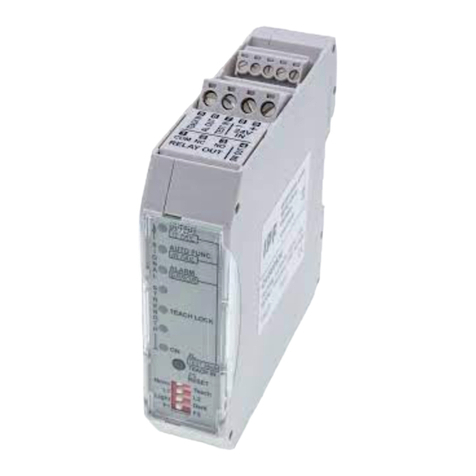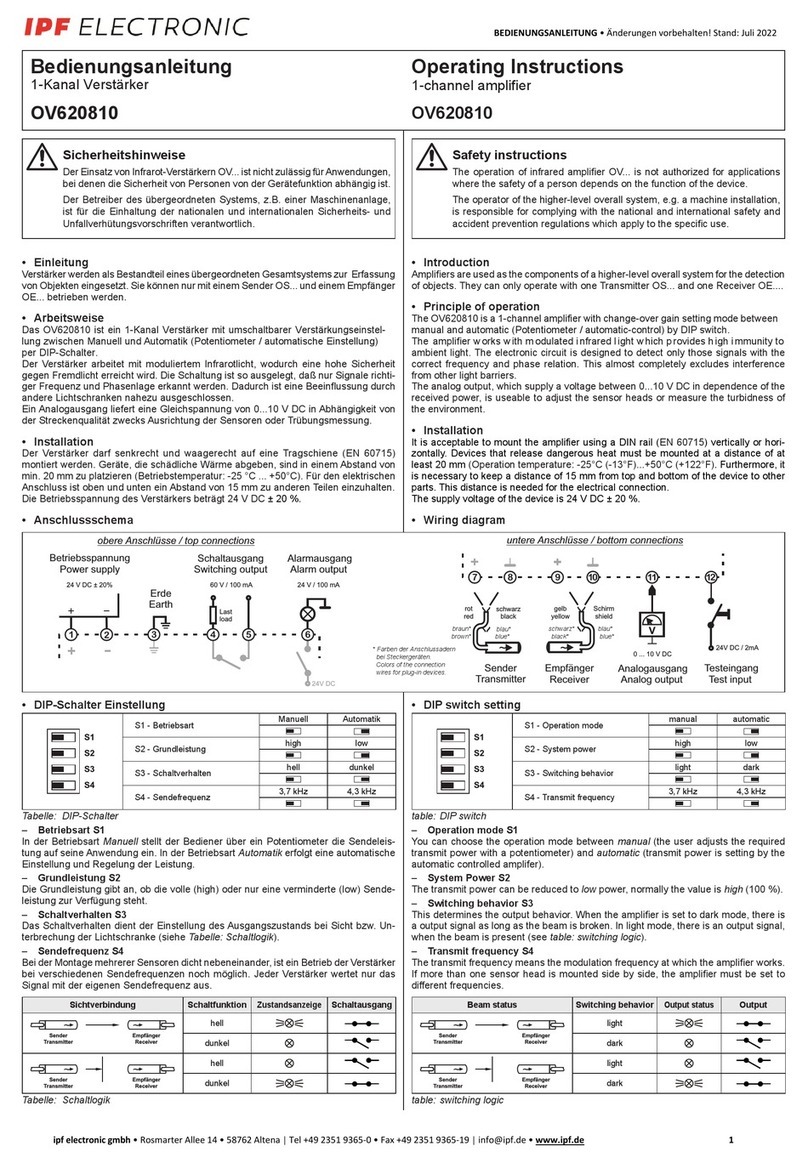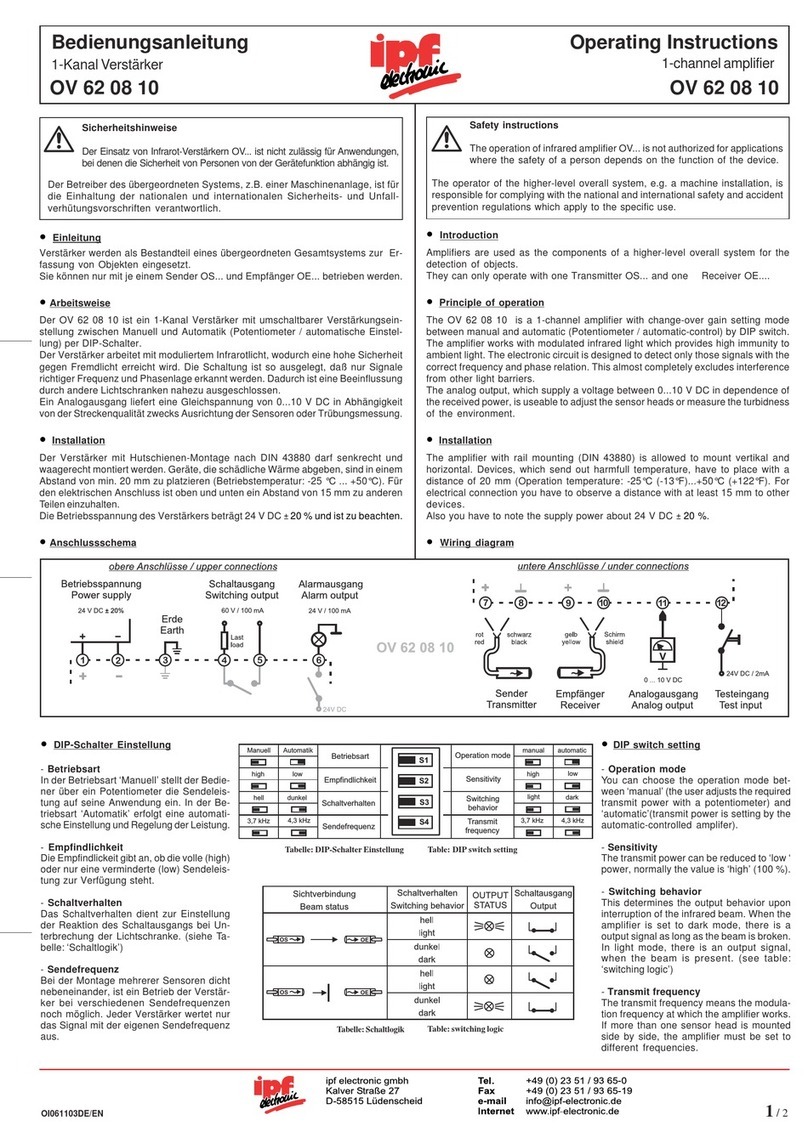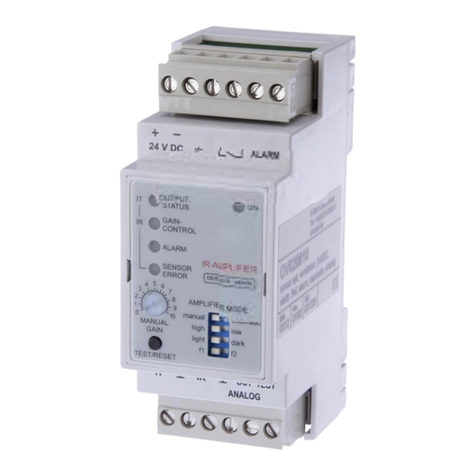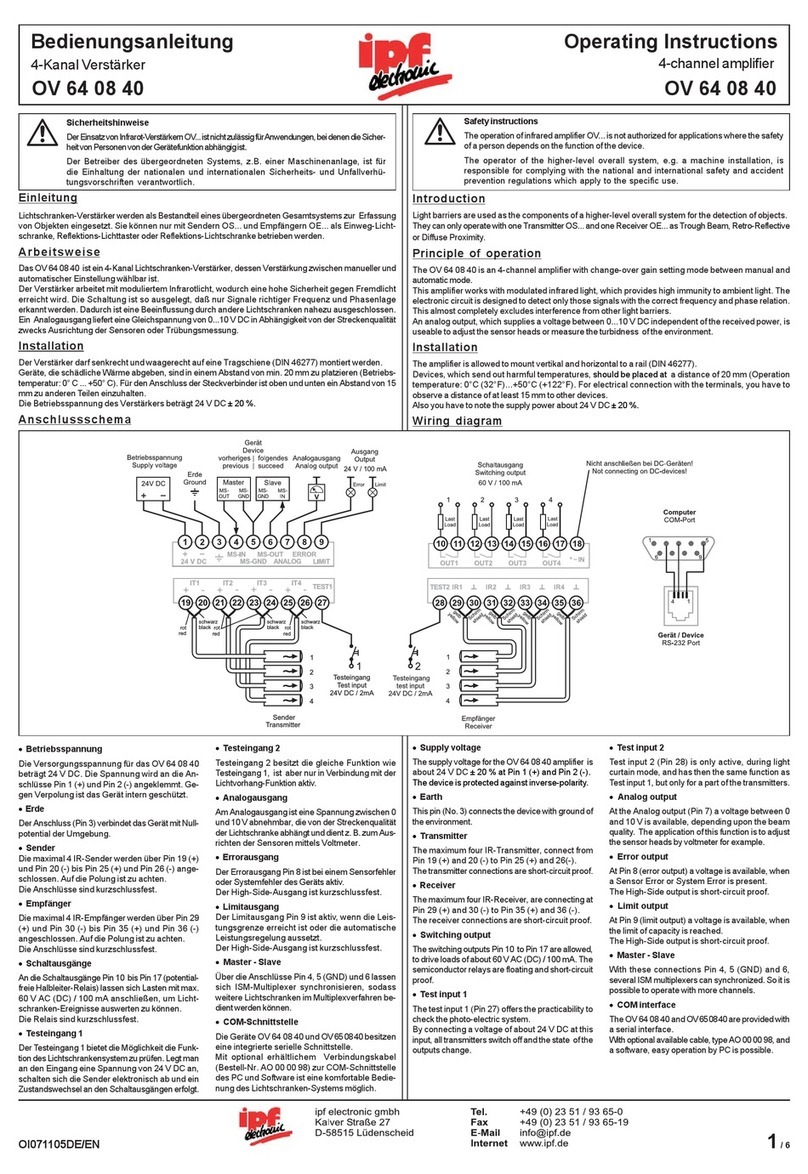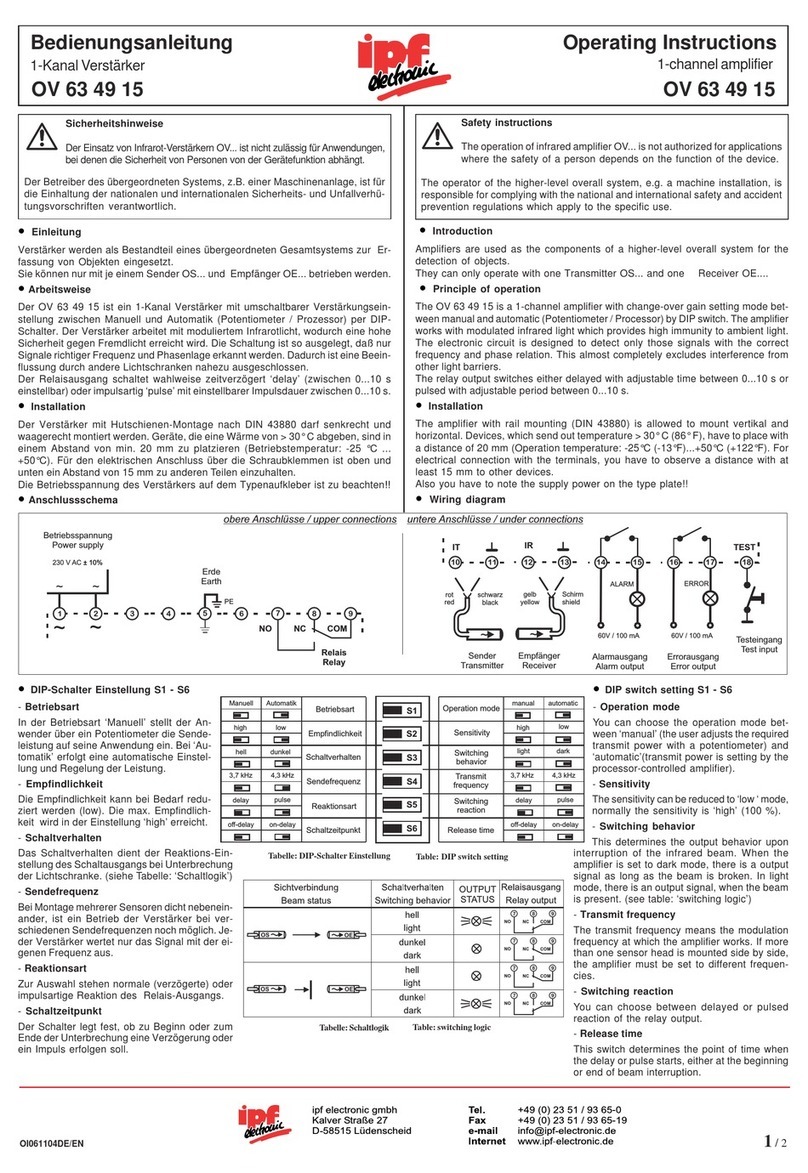
H1 H2
S7
S1 - S3
OUTPUT-
STATUS
OUTPUT-
STATUS
GAIN-
CONTROL
GAIN-
CONTROL
ALARM ON
TEST/RESET
high
high
manual
manual
low
low
automatic
automatic
dark
dark
light
light
MANUAL
GAIN
MANUAL
GAIN
SENSOR
ERROR
SENSOR
ERROR
AMPLIFIER MODE
IT IT
IR IR
CHANNEL1 CHANNEL2
Channel 1Channel 2
2-CHANNEL
INFRARED-AMPLIFIER
S4 - S6
H3 H4
H5 H6
P1 P2
H7 - H8
CH 1
CH 2
•Anzeigen und Bedienelemente
H1 - H2: Schaltzustand / Senderfehler-Anzeige - gelb
H3 - H4: Empndlichkeit / Empfängerfehler-Anzeige - grün
H5 - H6: Sensor-Fehler - rot
H7: Alarmanzeige - rot
H8: Betriebsanzeige - grün
P1-P2: Empndlichkeitseinsteller für Manuell-Betrieb
S1 - S3: DIP-Schalter Kanal 1
S4 - S6: DIP-Schalter Kanal 2
S7: Test / Reset-Taster
•Display content and operating elements
H1 - H2: Switching indicator / Transmitter error - yellow
H3 - H4: Sensitivity display / Receiver error - green
H5 - H6: Sensor Error display - red
H7: Alarm display - red
H8: Power On display - green
P1 - P2: Manual Gain control
S1 - S3: DIP-switch channel 1
S4 - S6: DIP-switch channel 2
S7: Test / Reset-Taster
•Inbetriebnahme
Vor Inbetriebnahme DIP-Schalter S1 - S3 (S4 - S6) am Gerät passend einstellen. Sen-
soren aufeinander ausrichten. Nach Anlegen der Betriebsspannung und automatischem
Reset, stellt sich in der Betriebsart Automatik die Sendeleistung selbstständig ein. Bei
fehlerfreiem Betrieb leuchtet H3 (H4) auf (Automatik aktiv). Gleichzeitig leuchtet in Hell-
schaltung H1 (H2). In der Betriebsart Manuell muss der Anwender die Sendeleistung mit
P1 (P2) auf die erforderliche Höhe bringen, sodass bei Sichtverbindung H3 (H4) leuchtet.
In Hellschaltung leuchtet auch hier gleichzeitig H1 (H2) (siehe Tabelle: Schaltlogik).
•- Alarm - mit Alarmausgang
Der Alarmzustand tritt ein, wenn die Sendeleistung im Manuell-Betrieb nicht ausreichend
ist, oder im Automatik-Betrieb der Prozessor nicht mehr nachregeln kann. Ursache
ist z. B. eine Verschlechterung der Sicht, eine zu große Distanz oder Dejustage der
Sensoren. Nach Beseitigung des Fehlers erlischt die Anzeige.
•Testeingang
Legt man an den Testeingang 24 V DC an, so schaltet der Sender ab. Damit kann die
Funktion der Lichtschranke überprüft werden.
•- Test -
Durch kurzes Drücken von S7 - Funktion Test - wird erst die Streckenqualität von Kanal
1 durch Blinken von H3 (1x - schlecht bis 10x - sehr gut) angezeigt. Ist keine Sichtver-
bindung vorhanden, blinkt lediglich H5. Danach folgt das Ergebnis von Kanal 2 mit H4.
Ist hier keine Sichtverbindung vorhanden, blinkt lediglich H6.
•- Reset -
Nach Anlegen der Betriebsspannung oder langes Drücken von S7, führt das Gerät
einen Reset durch. Der Reset beinhaltet einen Lampentest. Alle Anzeigen erlischen
und leuchten danach kurz auf. Zusätzlich ndet im Automatik-Betrieb eine automatische
Neuregelung der Sendeleistung vom Maximalwert auf den Sollwert statt.
•- Sensor Error - mit Errorausgang
Mit der Sensor Error-Funktion überwacht das Gerät den elektrischen Zustand der Sen-
soren auf Kurzschluss und Unterbrechung. Tritt ein Fehler auf, so meldet dies das Gerät
durch die Anzeigeelemente. Schnelles Blinken bedeutet Kurzschluss und langsames
Blinken bedeutet Unterbrechung (siehe Tabelle Logik Sensor Error).
•Operating procedure
Before operating procedure you have to choose the DIP switch setting S1 - S3 (S4-S6)
for your application. Sensor heads adjusts one on top of the other. After switch on the
power supply and automatic reset, the transmit power will be turned to the optimum
(Automatic mode). When there is no error LED H3 (H4) lights (automatic active) and
H1(H2) lights (in light switching mode). In the Manual mode you have to adjust the
transmit power with P1 (P2) until H3 (H4) signals sufcient power. In light switching
mode H1 (H2) lights too (See also table: Switching logic).
•- Alarm - with Alarm output
Alarm is active, when the transmit power is not sufcient in the Manual mode or the
automatic adjustment is interrupted. The cause can be e. g. deterioration of the beam,
too large distance or misadjustment of sensor heads. Is the cause removed, the alarm
is no longer active.
•Test input
With a voltage about 24 V DC at the test input, the transmitter beam switches off. With
this feature you can test the system.
•- Test -
Short-time pressing of button S7 results ashes between 1 and 10 times of H3 to signal
the received power of channel 1. They are proportional to the received signal. If there
is no received signal, only H5 ashes up. After that the same procedure starts with ch
2. Here H4 signals the quality and if there is no signal, only H6 ashes up.
•- Reset -
After connecting the device with power supply or pressing of button S7 for longer time,
a Reset will done. This means a test of all displays. All LEDs lights down and up for
a short time. Additionally in Automatic mode a new adjustment of the transmit power
starts from maximum to the nominal value.
•- Sensor Error - with error output
This function controls the electrical state of the sensor heads. If there is an error (short-
circuit or too high resistance resp. disconnection) H5 (H6) lights up. Additionally H1(H2)
(= transmitter error) or / and H3 (H4) (= receiver error) ashes slowly (= high resistance)
or fast (= short-circuit). See for this table Logic Sensor Error.
Logik Sensor Error | Logic Sensor Error
89,6
95
58
Maßzeichnungen in mm | Dimensions in mm
Technische Daten (bei 20 °C Ub= 24 V DC) OV630840 Technical data (at 20 °C (68 °F), Vs= 24 V DC)
Betriebsspannung 24 V DC / ± 20% / 3,6 W Supply power
Messverfahren moduliertes OE-Licht modulated OE-light Operating basis
max. Reichweite (Einweg) Max. range (Through beam)
Sender Empfänger / Receiver
OE 12 63...
Empfänger / Receiver
OE 10 60 ..., 12 60 ..., 13 60 ... Transmitter
OS 10 60 ..., 12 60 01, 12 60 03, 12 60 20, 13 60 ... 8 m (26 ft) 20 m (66 ft) OS 10 60 ..., 12 60 01, 12 60 03, 12 60 20, 13 60 ...
OS 12 60 08, 12 60 26 10 m (33 ft) 30 m (99 ft) OS 12 60 08, 12 60 26
OS 10 61 ..., 12 63 ... 20 m (66 ft) 55 m (182 ft) OS 10 61 ..., 12 63 ...
Sendefrequenz 3,9 kHz Transmit frequency
Multiplexgeschwindigkeit 8 ms Multiplex speed
Sendeleistung manuell / automatisch manual / automatic Transmit power
Schaltfunktion bzw. Schaltverhalten hell / dunkel light / dark Switching behavior
Grundleistung high / low System power manual mode
Schaltverzögerung / Impulsbreite — Switching delay / impulse period
Schaltausgang (kurzschlussfest) Schließer (Halbleiter-Relais) NO (Semiconductor-Relay) Switching output (short-circuit proof)
max. Schaltwerte 100 mA / 60 V AC (DC) values (max.)
Reaktionszeit 24 ms reaction time
Alarm-/Errorausgang (kurzschlussfest) pnp: 100 mA / 24 V DC Alarm / Error output (short-circuit proof)
Analogausgang — Analog output
Testeingang Activ HIGH (L= 0...5 V DC, H= 15...30 V DC) Test input
Gehäusewerkstoff NORYL RAL 7035 (grau / grey) Housing material
Schutzart IP 20 Protection class
Anschluss-Querschnitt 0,14 - 2,5 mm² Terminal size
Betriebstemperatur -25 °C...+50 °C (-13 °F...+122 °F) Operating temperature
Gehäuseabmessungen siehe Maßzeichnung see dimensions Housing measurements
BEDIENUNGSANLEITUNG •Änderungen vorbehalten! Stand: Juli 2022
ipf electronic gmbh
•Rosmarter Allee 14 •58762 Altena
│
Tel +49 2351 9365-0 •Fax +49 2351 9365-19
│
